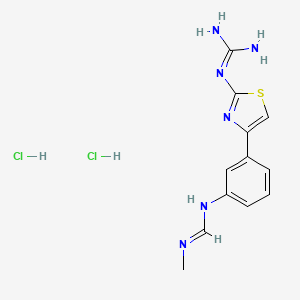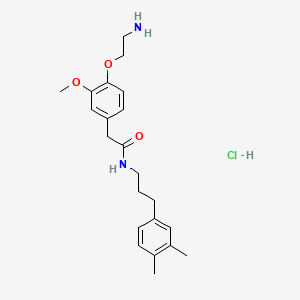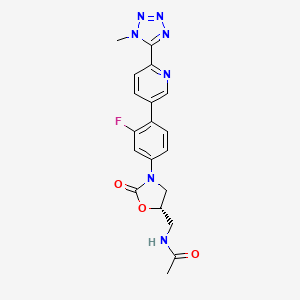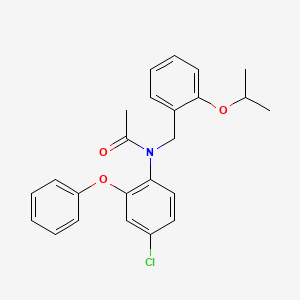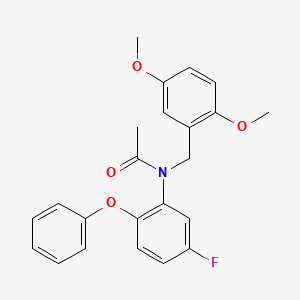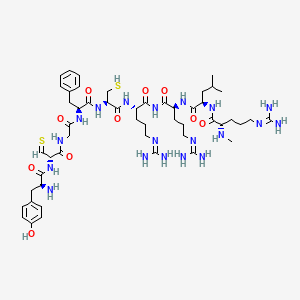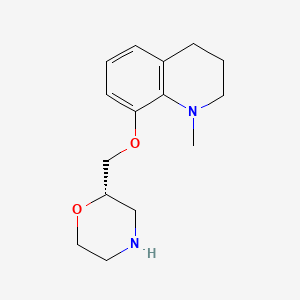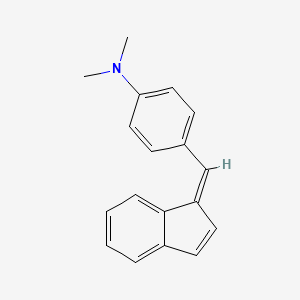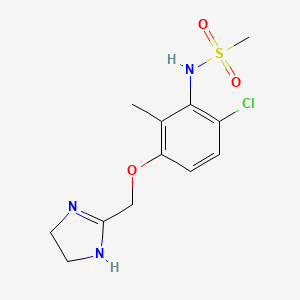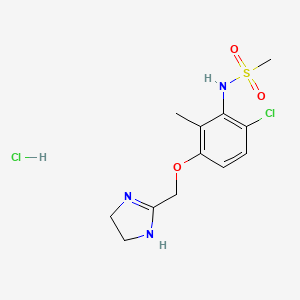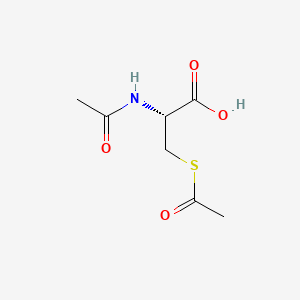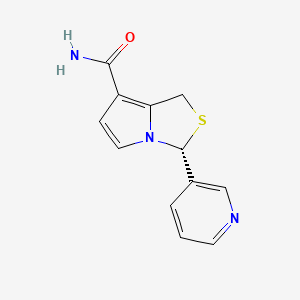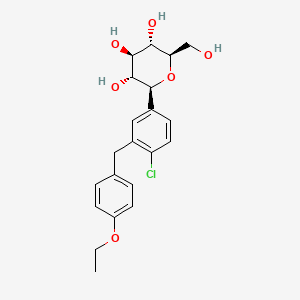
Dapagliflozin
Übersicht
Beschreibung
Dapagliflozin is a medication primarily used to treat type 2 diabetes mellitus. It belongs to the class of sodium-glucose co-transporter 2 inhibitors. By inhibiting this transporter, this compound reduces glucose reabsorption in the kidneys, leading to increased glucose excretion in the urine. This helps in lowering blood glucose levels. Additionally, this compound is used to treat heart failure and chronic kidney disease .
Wissenschaftliche Forschungsanwendungen
Dapagliflozin hat eine breite Palette von Anwendungen in der wissenschaftlichen Forschung:
Chemie: Als Modellverbindung verwendet, um das Verhalten von Natrium-Glukose-Cotransporter-2-Hemmern zu untersuchen.
Biologie: Auf seine Auswirkungen auf den Glukosestoffwechsel und die Nierenfunktion untersucht.
Medizin: Ausgiebig auf seine therapeutischen Wirkungen bei der Behandlung von Typ-2-Diabetes, Herzinsuffizienz und chronischer Nierenerkrankung untersucht. .
5. Wirkmechanismus
This compound wirkt durch die Hemmung des Natrium-Glukose-Cotransporters 2 in den proximalen Nierentubuli. Dieser Transporter ist für die Rückresorption von Glukose aus dem Tubuluslumen verantwortlich. Durch die Hemmung dieses Transporters reduziert this compound die Glukose-Rückresorption, was zu einer erhöhten Glukose-Ausscheidung im Urin führt. Dies führt zu einem niedrigeren Blutzuckerspiegel. Zusätzlich reduziert this compound die Natrium-Rückresorption, was mehrere physiologische Funktionen beeinflussen kann, darunter die Senkung der Vor- und Nachlast des Herzens und die Herunterregulierung der sympathischen Aktivität .
Ähnliche Verbindungen:
- Empagliflozin
- Canagliflozin
- Ipragliflozin
Vergleich:
- Empagliflozin: Sowohl this compound als auch Empagliflozin sind Natrium-Glukose-Cotransporter-2-Hemmer, die zur Behandlung von Typ-2-Diabetes eingesetzt werden. This compound hat im Vergleich zu Empagliflozin ein höheres Risiko für einen Herzinsuffizienz-bedingten Krankenhausaufenthalt gezeigt .
- Canagliflozin: Ähnlich wie this compound wird Canagliflozin zur Behandlung von Typ-2-Diabetes eingesetzt und bietet zusätzliche Vorteile bei der Reduzierung von Herz-Kreislauf-Ereignissen. Canagliflozin wurde mit einem höheren Risiko für Amputationen der unteren Gliedmaßen in Verbindung gebracht.
- Ipragliflozin: Ein weiterer Natrium-Glukose-Cotransporter-2-Hemmer mit ähnlichen blutzuckersenkenden Wirkungen. This compound hat ein günstigeres Sicherheitsprofil in Bezug auf Genitalinfektionen .
This compound zeichnet sich durch seine umfassenden Vorteile bei der Behandlung von Typ-2-Diabetes, Herzinsuffizienz und chronischer Nierenerkrankung sowie durch sein relativ günstiges Sicherheitsprofil aus.
Wirkmechanismus
Target of Action
Dapagliflozin primarily targets the sodium-glucose cotransporter 2 (SGLT2) . SGLT2 is predominantly expressed in the proximal tubule of the nephron in the kidneys . It is responsible for mediating approximately 90% of glucose reabsorption in the kidneys .
Mode of Action
This compound acts as a highly potent, selective, and reversible inhibitor of SGLT2 . By blocking this protein, this compound prevents glucose reabsorption, leading to glucose excretion in the urine . This process is known as glycosuria , which helps to improve glycemic control .
Biochemical Pathways
This compound influences several biochemical pathways. Primarily, it affects glucose metabolism , specifically the glycolysis/gluconeogenesis and pentose phosphate pathways . By inhibiting glucose reabsorption, this compound indirectly influences these pathways, leading to changes in the body’s glucose levels . Additionally, this compound has been found to impact the PI3K-Akt-eNOS pathway, which plays a role in angiogenesis .
Pharmacokinetics
This compound is rapidly absorbed when administered orally, generally achieving peak plasma concentrations within 2 hours . It has an oral bioavailability of 78% . This compound is metabolized predominantly in the liver and kidneys by uridine diphosphate-glucuronosyltransferase-1A9 to the major metabolite this compound 3-O-glucuronide . The half-life for orally administered this compound is approximately 12.9 hours .
Result of Action
The primary result of this compound’s action is improved glycemic control in patients with type 2 diabetes mellitus . By causing glycosuria, this compound reduces blood glucose levels, which can help manage diabetes . Additionally, this compound has been shown to have a positive impact on arterial stiffness and contributes to a reduced risk of cardiovascular complications .
Action Environment
Environmental factors can influence the action, efficacy, and stability of this compound. For instance, the compound is water-soluble and hydrolytically stable in the aquatic environment . In domestic sewage, it is unlikely that this compound would significantly partition to the sludge solids during wastewater treatment . These environmental factors can impact the distribution and degradation of this compound in the environment .
Biochemische Analyse
Biochemical Properties
Dapagliflozin plays a crucial role in biochemical reactions by inhibiting the SGLT2 protein, which is predominantly expressed in the proximal renal tubules. This inhibition prevents glucose reabsorption, leading to its excretion through urine. This compound interacts with various enzymes and proteins, including sex hormone-binding globulin, transferrin receptor protein 1, disintegrin, metalloprotease-like decysin-1, and apolipoprotein A-IV, increasing their levels. Conversely, it decreases the levels of complement C3, fibronectin, afamin, attractin, xanthine, and uric acid .
Cellular Effects
This compound influences various cell types and cellular processes. It enhances insulin sensitivity in hepatic and adipose tissues, leading to improved glucose metabolism. This compound also affects cell signaling pathways, such as the MYD88, NLRP3 complex, Leukotrienes/Interleukin 6 axis, and mTORC1/Fox01/3a mediated apoptosis . These interactions result in changes in gene expression and cellular metabolism, contributing to its therapeutic effects.
Molecular Mechanism
At the molecular level, this compound exerts its effects by binding to the SGLT2 protein, inhibiting its function, and preventing glucose reabsorption in the kidneys. This inhibition leads to increased urinary glucose excretion, mimicking caloric restriction and promoting fat oxidation . This compound also influences gene expression by modulating the activity of various transcription factors and signaling pathways, contributing to its beneficial effects on glucose metabolism and insulin sensitivity.
Temporal Effects in Laboratory Settings
In laboratory settings, the effects of this compound change over time. Studies have shown that this compound treatment for 12 weeks significantly decreases HbA1c, BMI, and HOMA-IR in patients with type 2 diabetes . The stability and degradation of this compound in vitro and in vivo settings are crucial for understanding its long-term effects on cellular function. This compound has been shown to maintain its efficacy over extended periods, with consistent improvements in metabolic parameters.
Dosage Effects in Animal Models
The effects of this compound vary with different dosages in animal models. At therapeutic doses, this compound effectively reduces glucose levels and improves insulin sensitivity. At higher doses, it may cause adverse effects, such as dehydration and electrolyte imbalances. Studies have identified threshold effects, where the benefits of this compound plateau beyond a certain dosage, emphasizing the importance of optimal dosing for therapeutic efficacy .
Metabolic Pathways
This compound is involved in several metabolic pathways, including glycolysis, gluconeogenesis, and the pentose phosphate pathway. It interacts with enzymes such as UGT1A9, which metabolizes this compound to its major inactive metabolite 3-O-glucuronide . These interactions influence metabolic flux and metabolite levels, contributing to the overall metabolic effects of this compound.
Transport and Distribution
This compound is transported and distributed within cells and tissues through various transporters and binding proteins. It is primarily localized in the kidneys, where it exerts its glucose-lowering effects by inhibiting SGLT2. The distribution of this compound within other tissues, such as the liver and adipose tissue, also contributes to its metabolic effects .
Subcellular Localization
The subcellular localization of this compound is primarily in the proximal renal tubules, where it inhibits SGLT2. This localization is crucial for its activity and function, as it directly affects glucose reabsorption in the kidneys. This compound may also undergo post-translational modifications that influence its targeting to specific compartments or organelles, further modulating its therapeutic effects .
Vorbereitungsmethoden
Synthesewege und Reaktionsbedingungen: Die Synthese von Dapagliflozin umfasst mehrere wichtige Schritte:
Herstellung des Grignard-Reagenzes: Der anfängliche Rohstoff, 1-Chlor-2-(4-Ethoxybenzyl)-4-iodbenzol, reagiert mit Magnesium unter Verwendung von Iodkörnern als Initiator zur Herstellung eines Grignard-Reagenzes.
Bromierungsreaktion: Peracetylierter Zucker reagiert mit Bromwasserstoff in einer Essigsäurelösung zur Herstellung von 2,3,4,6-Tetraacetylglucosaminbromid.
Bildung der Zwischenverbindung: Das Grignard-Reagenz wird einer Methylbenzol/Tetrahydrofuran-Lösung zugesetzt, gefolgt von der Zugabe eines Seltenerdmetallkatalysators und 2,3,4,6-Tetraacetylglucosaminbromid, was zu einer Zwischenverbindung führt.
Hydrolyse und Umkristallisation: Die Zwischenverbindung wird in einer Tetrahydrofuran/Ethanol/Wasser-Lösung von Natriumhydroxid einer alkalischen Hydrolyse unterzogen, gefolgt von einer Umkristallisation, um this compound zu erhalten.
Industrielle Produktionsmethoden: Die industrielle Produktion von this compound folgt ähnlichen Synthesewegen, aber in größerem Maßstab, um eine hohe Reinheit und Ausbeute zu gewährleisten. Der Prozess umfasst strenge Qualitätskontrollmaßnahmen, um Verunreinigungen zu minimieren und die Konsistenz des Endprodukts zu gewährleisten .
Arten von Reaktionen:
Oxidation: this compound kann Oxidationsreaktionen eingehen, die zur Bildung von Metaboliten wie Oxo-Dapagliflozin führen.
Reduktion: Reduktionsreaktionen können this compound in seine reduzierten Formen umwandeln.
Substitution: Substitutionsreaktionen können an verschiedenen Positionen des this compound-Moleküls auftreten, was zur Bildung verschiedener Derivate führt.
Häufige Reagenzien und Bedingungen:
Oxidation: Häufige Oxidationsmittel sind Wasserstoffperoxid und Kaliumpermanganat.
Reduktion: Als Reduktionsmittel werden Natriumborhydrid und Lithiumaluminiumhydrid verwendet.
Substitution: Verschiedene Halogenierungsmittel und Nucleophile werden bei Substitutionsreaktionen eingesetzt.
Hauptprodukte:
Benzylischer Hydroxy-Dapagliflozin: Durch Hydroxylierung gebildet.
Oxo-Dapagliflozin: Durch Oxidation gebildet.
Desethyl-Dapagliflozin: Durch Deethylierung gebildet.
Vergleich Mit ähnlichen Verbindungen
- Empagliflozin
- Canagliflozin
- Ipragliflozin
Comparison:
- Empagliflozin: Both dapagliflozin and empagliflozin are sodium-glucose co-transporter 2 inhibitors used to treat type 2 diabetes. this compound has shown a higher risk of hospitalization for heart failure compared to empagliflozin .
- Canagliflozin: Similar to this compound, canagliflozin is used to treat type 2 diabetes and has additional benefits in reducing cardiovascular events. canagliflozin has been associated with a higher risk of lower limb amputations.
- Ipragliflozin: Another sodium-glucose co-transporter 2 inhibitor with similar glucose-lowering effects. this compound has a more favorable safety profile in terms of genital infections .
This compound stands out due to its comprehensive benefits in treating type 2 diabetes, heart failure, and chronic kidney disease, along with its relatively favorable safety profile.
Eigenschaften
IUPAC Name |
(2S,3R,4R,5S,6R)-2-[4-chloro-3-[(4-ethoxyphenyl)methyl]phenyl]-6-(hydroxymethyl)oxane-3,4,5-triol | |
|---|---|---|
| Source | PubChem | |
| URL | https://pubchem.ncbi.nlm.nih.gov | |
| Description | Data deposited in or computed by PubChem | |
InChI |
InChI=1S/C21H25ClO6/c1-2-27-15-6-3-12(4-7-15)9-14-10-13(5-8-16(14)22)21-20(26)19(25)18(24)17(11-23)28-21/h3-8,10,17-21,23-26H,2,9,11H2,1H3/t17-,18-,19+,20-,21+/m1/s1 | |
| Source | PubChem | |
| URL | https://pubchem.ncbi.nlm.nih.gov | |
| Description | Data deposited in or computed by PubChem | |
InChI Key |
JVHXJTBJCFBINQ-ADAARDCZSA-N | |
| Source | PubChem | |
| URL | https://pubchem.ncbi.nlm.nih.gov | |
| Description | Data deposited in or computed by PubChem | |
Canonical SMILES |
CCOC1=CC=C(C=C1)CC2=C(C=CC(=C2)C3C(C(C(C(O3)CO)O)O)O)Cl | |
| Source | PubChem | |
| URL | https://pubchem.ncbi.nlm.nih.gov | |
| Description | Data deposited in or computed by PubChem | |
Isomeric SMILES |
CCOC1=CC=C(C=C1)CC2=C(C=CC(=C2)[C@H]3[C@@H]([C@H]([C@@H]([C@H](O3)CO)O)O)O)Cl | |
| Source | PubChem | |
| URL | https://pubchem.ncbi.nlm.nih.gov | |
| Description | Data deposited in or computed by PubChem | |
Molecular Formula |
C21H25ClO6 | |
| Source | PubChem | |
| URL | https://pubchem.ncbi.nlm.nih.gov | |
| Description | Data deposited in or computed by PubChem | |
DSSTOX Substance ID |
DTXSID20905104 | |
| Record name | Dapagliflozin | |
| Source | EPA DSSTox | |
| URL | https://comptox.epa.gov/dashboard/DTXSID20905104 | |
| Description | DSSTox provides a high quality public chemistry resource for supporting improved predictive toxicology. | |
Molecular Weight |
408.9 g/mol | |
| Source | PubChem | |
| URL | https://pubchem.ncbi.nlm.nih.gov | |
| Description | Data deposited in or computed by PubChem | |
Mechanism of Action |
Dapagliflozin inhibits the sodium-glucose contransporter 2(SGLT2) which is primarily located in the proximal tubule of the nephron. SGLT2 facilitates 90% of glucose reabsorption in the kidneys and so its inhibition allows for glucose to be excreted in the urine. This excretion allows for better glycemic control and potentially weight loss in patients with type 2 diabetes mellitus. | |
| Record name | Dapagliflozin | |
| Source | DrugBank | |
| URL | https://www.drugbank.ca/drugs/DB06292 | |
| Description | The DrugBank database is a unique bioinformatics and cheminformatics resource that combines detailed drug (i.e. chemical, pharmacological and pharmaceutical) data with comprehensive drug target (i.e. sequence, structure, and pathway) information. | |
| Explanation | Creative Common's Attribution-NonCommercial 4.0 International License (http://creativecommons.org/licenses/by-nc/4.0/legalcode) | |
CAS No. |
461432-26-8 | |
| Record name | Dapagliflozin | |
| Source | CAS Common Chemistry | |
| URL | https://commonchemistry.cas.org/detail?cas_rn=461432-26-8 | |
| Description | CAS Common Chemistry is an open community resource for accessing chemical information. Nearly 500,000 chemical substances from CAS REGISTRY cover areas of community interest, including common and frequently regulated chemicals, and those relevant to high school and undergraduate chemistry classes. This chemical information, curated by our expert scientists, is provided in alignment with our mission as a division of the American Chemical Society. | |
| Explanation | The data from CAS Common Chemistry is provided under a CC-BY-NC 4.0 license, unless otherwise stated. | |
| Record name | Dapagliflozin [USAN:INN] | |
| Source | ChemIDplus | |
| URL | https://pubchem.ncbi.nlm.nih.gov/substance/?source=chemidplus&sourceid=0461432268 | |
| Description | ChemIDplus is a free, web search system that provides access to the structure and nomenclature authority files used for the identification of chemical substances cited in National Library of Medicine (NLM) databases, including the TOXNET system. | |
| Record name | Dapagliflozin | |
| Source | DrugBank | |
| URL | https://www.drugbank.ca/drugs/DB06292 | |
| Description | The DrugBank database is a unique bioinformatics and cheminformatics resource that combines detailed drug (i.e. chemical, pharmacological and pharmaceutical) data with comprehensive drug target (i.e. sequence, structure, and pathway) information. | |
| Explanation | Creative Common's Attribution-NonCommercial 4.0 International License (http://creativecommons.org/licenses/by-nc/4.0/legalcode) | |
| Record name | Dapagliflozin | |
| Source | EPA DSSTox | |
| URL | https://comptox.epa.gov/dashboard/DTXSID20905104 | |
| Description | DSSTox provides a high quality public chemistry resource for supporting improved predictive toxicology. | |
| Record name | (1S)-1,5-anhydro-1-C-[4-chloro-3-[(4-ethoxyphenyl)methyl]phenyl]-D-glucitol | |
| Source | European Chemicals Agency (ECHA) | |
| URL | https://echa.europa.eu/information-on-chemicals | |
| Description | The European Chemicals Agency (ECHA) is an agency of the European Union which is the driving force among regulatory authorities in implementing the EU's groundbreaking chemicals legislation for the benefit of human health and the environment as well as for innovation and competitiveness. | |
| Explanation | Use of the information, documents and data from the ECHA website is subject to the terms and conditions of this Legal Notice, and subject to other binding limitations provided for under applicable law, the information, documents and data made available on the ECHA website may be reproduced, distributed and/or used, totally or in part, for non-commercial purposes provided that ECHA is acknowledged as the source: "Source: European Chemicals Agency, http://echa.europa.eu/". Such acknowledgement must be included in each copy of the material. ECHA permits and encourages organisations and individuals to create links to the ECHA website under the following cumulative conditions: Links can only be made to webpages that provide a link to the Legal Notice page. | |
| Record name | DAPAGLIFLOZIN | |
| Source | FDA Global Substance Registration System (GSRS) | |
| URL | https://gsrs.ncats.nih.gov/ginas/app/beta/substances/1ULL0QJ8UC | |
| Description | The FDA Global Substance Registration System (GSRS) enables the efficient and accurate exchange of information on what substances are in regulated products. Instead of relying on names, which vary across regulatory domains, countries, and regions, the GSRS knowledge base makes it possible for substances to be defined by standardized, scientific descriptions. | |
| Explanation | Unless otherwise noted, the contents of the FDA website (www.fda.gov), both text and graphics, are not copyrighted. They are in the public domain and may be republished, reprinted and otherwise used freely by anyone without the need to obtain permission from FDA. Credit to the U.S. Food and Drug Administration as the source is appreciated but not required. | |
Retrosynthesis Analysis
AI-Powered Synthesis Planning: Our tool employs the Template_relevance Pistachio, Template_relevance Bkms_metabolic, Template_relevance Pistachio_ringbreaker, Template_relevance Reaxys, Template_relevance Reaxys_biocatalysis model, leveraging a vast database of chemical reactions to predict feasible synthetic routes.
One-Step Synthesis Focus: Specifically designed for one-step synthesis, it provides concise and direct routes for your target compounds, streamlining the synthesis process.
Accurate Predictions: Utilizing the extensive PISTACHIO, BKMS_METABOLIC, PISTACHIO_RINGBREAKER, REAXYS, REAXYS_BIOCATALYSIS database, our tool offers high-accuracy predictions, reflecting the latest in chemical research and data.
Strategy Settings
| Precursor scoring | Relevance Heuristic |
|---|---|
| Min. plausibility | 0.01 |
| Model | Template_relevance |
| Template Set | Pistachio/Bkms_metabolic/Pistachio_ringbreaker/Reaxys/Reaxys_biocatalysis |
| Top-N result to add to graph | 6 |
Feasible Synthetic Routes
Q1: What is the primary mechanism of action of dapagliflozin?
A1: this compound selectively inhibits SGLT2, a protein primarily located in the S1 segment of the proximal convoluted tubule in the kidneys []. SGLT2 is responsible for the majority of glucose reabsorption from the glomerular filtrate back into the bloodstream. By inhibiting SGLT2, this compound promotes urinary glucose excretion, thereby lowering blood glucose levels independently of insulin secretion or sensitivity [].
Q2: Does this compound affect other SGLT transporters in the body?
A2: this compound demonstrates high selectivity for SGLT2 over SGLT1, another glucose transporter found in the intestines and kidneys []. This selectivity is crucial as SGLT1 inhibition can lead to gastrointestinal side effects.
Q3: How does this compound impact glucose homeostasis in the liver?
A3: While this compound primarily acts in the kidneys, research suggests it can influence hepatic glucose metabolism. Studies in obese Zucker rats show this compound increases hepatic fatty acid oxidation and ketone body formation []. This effect is attributed to the increased reliance on fatty acids as fuel in the context of this compound-induced glycosuria, mimicking a fasting state [].
Q4: Beyond its glucose-lowering effects, what other potential benefits has this compound demonstrated in preclinical studies?
A4: Preclinical studies indicate this compound may offer benefits beyond glycemic control. These include:
- Cardioprotection: Research suggests this compound may protect against doxorubicin and trastuzumab-induced cardiotoxicity by reducing oxidative stress and inflammation in cardiomyocytes [, ].
- Neuroprotection: Studies in diabetic mice indicate this compound may protect retinal neural and vascular function by reducing inflammation and improving glycemic control [].
- Renal Protection: While some research suggests this compound may increase the risk of certain renal events [], other studies indicate potential benefits. For instance, this compound has been shown to attenuate contrast-induced acute kidney injury by regulating the HIF-1α/HE4/NF-κB pathway [].
- Testicular Function: this compound has been observed to improve testicular structure and sperm quality in diabetic mice, potentially through the activation of the GLP-1R/PI3K/Akt signaling pathway [].
Q5: What is the molecular formula and weight of this compound?
A5: The molecular formula of this compound propanediol monohydrate is C21H25ClO6 • C3H8O2, and its molecular weight is 480.9 g/mol. Information regarding the molecular formula and weight of this compound formate is unavailable in the provided abstracts.
Q6: How is this compound metabolized in the body?
A6: this compound is primarily metabolized by UGT1A1, an enzyme involved in glucuronidation, to an inactive metabolite, this compound 3-O-glucuronide [].
Q7: What is the primary route of elimination for this compound?
A7: this compound is mainly eliminated through the kidneys with a mean plasma terminal half-life of 12.9 hours after a single 10 mg oral dose [].
Q8: Has research investigated the pharmacokinetic profile of this compound formate (DAP-FOR)?
A8: A study comparing this compound formate (DAP-FOR) to this compound propanediol monohydrate (DAP-PDH) in healthy subjects showed DAP-FOR is rapidly converted into this compound, resulting in very low DAP-FOR exposure []. This rapid conversion leads to comparable pharmacokinetic profiles of this compound between the two formulations.
Q9: Are there specific patient populations where this compound's efficacy may be influenced?
A9: Research suggests the efficacy of this compound may vary depending on patient characteristics:
- Baseline Blood Pressure: this compound's benefits on heart failure and renal outcomes were consistent across different baseline systolic blood pressure categories, suggesting its efficacy is independent of blood pressure levels [].
- Kidney Function: In patients with heart failure and mildly reduced or preserved ejection fraction, this compound's benefits on the primary outcome of cardiovascular death or worsening heart failure were consistent regardless of baseline kidney function [].
- Diet: The efficacy of this compound might be attenuated in individuals consuming a low-carbohydrate diet compared to a normal carbohydrate diet []. Studies in mice suggest this difference may be attributed to variations in liver metabolism between the two dietary groups.
Q10: What are some promising areas of ongoing research related to this compound?
A13: * Biomarkers: Identifying biomarkers to predict treatment response, monitor efficacy, and assess the risk of adverse events is crucial. Ongoing research focuses on discovering reliable biomarkers for this compound therapy [, ].* Drug Delivery: Developing targeted drug delivery strategies could potentially enhance this compound's efficacy and minimize off-target effects [].* Combination Therapies: Exploring the synergistic potential of this compound with other antidiabetic agents, such as GLP-1 receptor agonists [], holds promise for optimizing glycemic control and patient outcomes.
Haftungsausschluss und Informationen zu In-Vitro-Forschungsprodukten
Bitte beachten Sie, dass alle Artikel und Produktinformationen, die auf BenchChem präsentiert werden, ausschließlich zu Informationszwecken bestimmt sind. Die auf BenchChem zum Kauf angebotenen Produkte sind speziell für In-vitro-Studien konzipiert, die außerhalb lebender Organismen durchgeführt werden. In-vitro-Studien, abgeleitet von dem lateinischen Begriff "in Glas", beinhalten Experimente, die in kontrollierten Laborumgebungen unter Verwendung von Zellen oder Geweben durchgeführt werden. Es ist wichtig zu beachten, dass diese Produkte nicht als Arzneimittel oder Medikamente eingestuft sind und keine Zulassung der FDA für die Vorbeugung, Behandlung oder Heilung von medizinischen Zuständen, Beschwerden oder Krankheiten erhalten haben. Wir müssen betonen, dass jede Form der körperlichen Einführung dieser Produkte in Menschen oder Tiere gesetzlich strikt untersagt ist. Es ist unerlässlich, sich an diese Richtlinien zu halten, um die Einhaltung rechtlicher und ethischer Standards in Forschung und Experiment zu gewährleisten.


